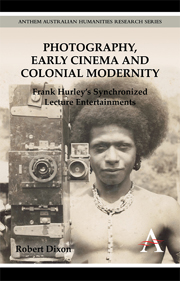Book contents
- Frontmatter
- Contents
- List of Illustrations
- List of Abbreviations
- Acknowledgements
- Introduction
- Chapter One The Home of the Blizzard: Douglas Mawson's Synchronized Lecture Entertainment
- Chapter Two Guided Spectatorship: Exhibiting the Great War
- Chapter Three Touring the Nation: Shackleton's ‘Marvellous Moving Pictures’ and the Australian Season of In the Grip of the Polar Pack-Ice
- Chapter Four Entr'acte: Sir Ross Smith's Flight, Aerial Vision and Colonial Modernity
- Chapter Five Colonial Modernity and Its Others: Pearls and Savages as a Multimedia Project
- Conclusion
- Notes
- Bibliography
- Index
Chapter Two - Guided Spectatorship: Exhibiting the Great War
Published online by Cambridge University Press: 05 May 2012
- Frontmatter
- Contents
- List of Illustrations
- List of Abbreviations
- Acknowledgements
- Introduction
- Chapter One The Home of the Blizzard: Douglas Mawson's Synchronized Lecture Entertainment
- Chapter Two Guided Spectatorship: Exhibiting the Great War
- Chapter Three Touring the Nation: Shackleton's ‘Marvellous Moving Pictures’ and the Australian Season of In the Grip of the Polar Pack-Ice
- Chapter Four Entr'acte: Sir Ross Smith's Flight, Aerial Vision and Colonial Modernity
- Chapter Five Colonial Modernity and Its Others: Pearls and Savages as a Multimedia Project
- Conclusion
- Notes
- Bibliography
- Index
Summary
As William Heinemann explained to Mawson, with the outbreak of war in August 1914 there was a sudden collapse in the popularity of shows about polar exploration, including Ponting's With Captain Scott in the Antarctic and Mawson's The Home of the Blizzard, and it was not really until the late 1940s that the British feature film industry rediscovered Antarctic exploration's heroic age. It was for this reason, as I discuss in chapter three, that Shackleton delayed the premier of his own lectures on the Imperial Trans-Antarctic Expedition until the London season of 1919–1920. Almost at once, however, there were plans for exhibitions about the war itself that also involved the synchronized use of lectures, photographs, lantern slides, cinema, musical accompaniment, tie-in newspaper coverage and the display of war relics such as flags, uniforms, aircraft and artillery. While much has been written about representations of the Great War in the emerging mass media, especially the cinema and the periodical press, my focus in this chapter is on the use of Hurley's war photographs in these multimedia exhibitions. Between the final year of the war and 1923 – when volume XII of the Official History of Australia in the War of 1914–1918, the definitive Photographic Record of the War, was published – there were at least nine major exhibitions and related publications in which Hurley's photographs were used.
- Type
- Chapter
- Information
- Photography, Early Cinema and Colonial ModernityFrank Hurley's Synchronized Lecture Entertainments, pp. 39 - 108Publisher: Anthem PressPrint publication year: 2012



